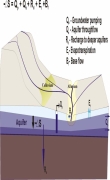 This presentation by ACWADAM deals with the subject of groundwater balance. It begins by describing the skeleton for the water balance equation viz., ground surface, soil, aquifer and bed rock. It describes the processes subsequent to rainfall such as interception, initial detention, depression storage, infiltration, runoff, streamflow, soil moisture retention and recharge.
This presentation by ACWADAM deals with the subject of groundwater balance. It begins by describing the skeleton for the water balance equation viz., ground surface, soil, aquifer and bed rock. It describes the processes subsequent to rainfall such as interception, initial detention, depression storage, infiltration, runoff, streamflow, soil moisture retention and recharge.
The watershed water balance equation is explained in terms of input (rainfall and water transfers) and output (runoff, evapotranspiration and infiltration). It notes that the input to a generalized water balance is rainfall whereas the input to a groundwater balance is infiltration. The difference between infiltration & recharge, natural & artificial recharge and interflow & discharge are explained thereafter. The water balance for an aquifer may vary, depending upon the nature of groundwater system –
- Watershed with a deep aquifer
- Watershed has both shallow and deep aquifers
- Watershed has only shallow aquifer
To conclude, the presentation deals with how to equate recharge and discharge-
- In areas where the aquifer empties and fills up each year (a good balance between recharge and discharge), the value of net groundwater discharge is equal.
- In other words, the net discharge of 190 mm is the recharge required in the case in question (Neemkheda watershed, Dewas) to fill up the aquifer to its original capacity.
- This means that if the rainfall is 550 mm annually, nearly 34%, of the rainfall is required to recharge the aquifer.
- This estimate of recharge can also be called potential recharge.
This presentation is part of the training modules on planning, development and management of groundwater with special reference to watershed management programmes by ACWADAM. Please write to ACWADAM at acwadam@vsnl.net for sourcing these presentations.